Air New Zealand: Business Analysis and Sustainability Initiatives
VerifiedAdded on 2023/06/11
|11
|3420
|93
Report
AI Summary
This business report provides a comprehensive analysis of Air New Zealand, examining its internal and external environments. The internal analysis considers reputational, tangible, human, innovational, and relational resources, alongside cultural aspects like long-term orientation and individualism. The external analysis employs the PESTLE framework to assess political, economic, social, technological, legal, and environmental factors impacting the airline. The report also highlights four key sustainability initiatives undertaken by Air New Zealand, including carbon footprint reduction, tourism sector growth, community contributions, and sustainable business practices. It further discusses the positive impacts of these initiatives on the company's resource utilization, stakeholder engagement, and overall business success. The report concludes by emphasizing the importance of sustainability in the aviation industry and Air New Zealand's commitment to sustainable economic growth and reduced environmental impact.

Business report on Air New Zealand
1
1
Paraphrase This Document
Need a fresh take? Get an instant paraphrase of this document with our AI Paraphraser
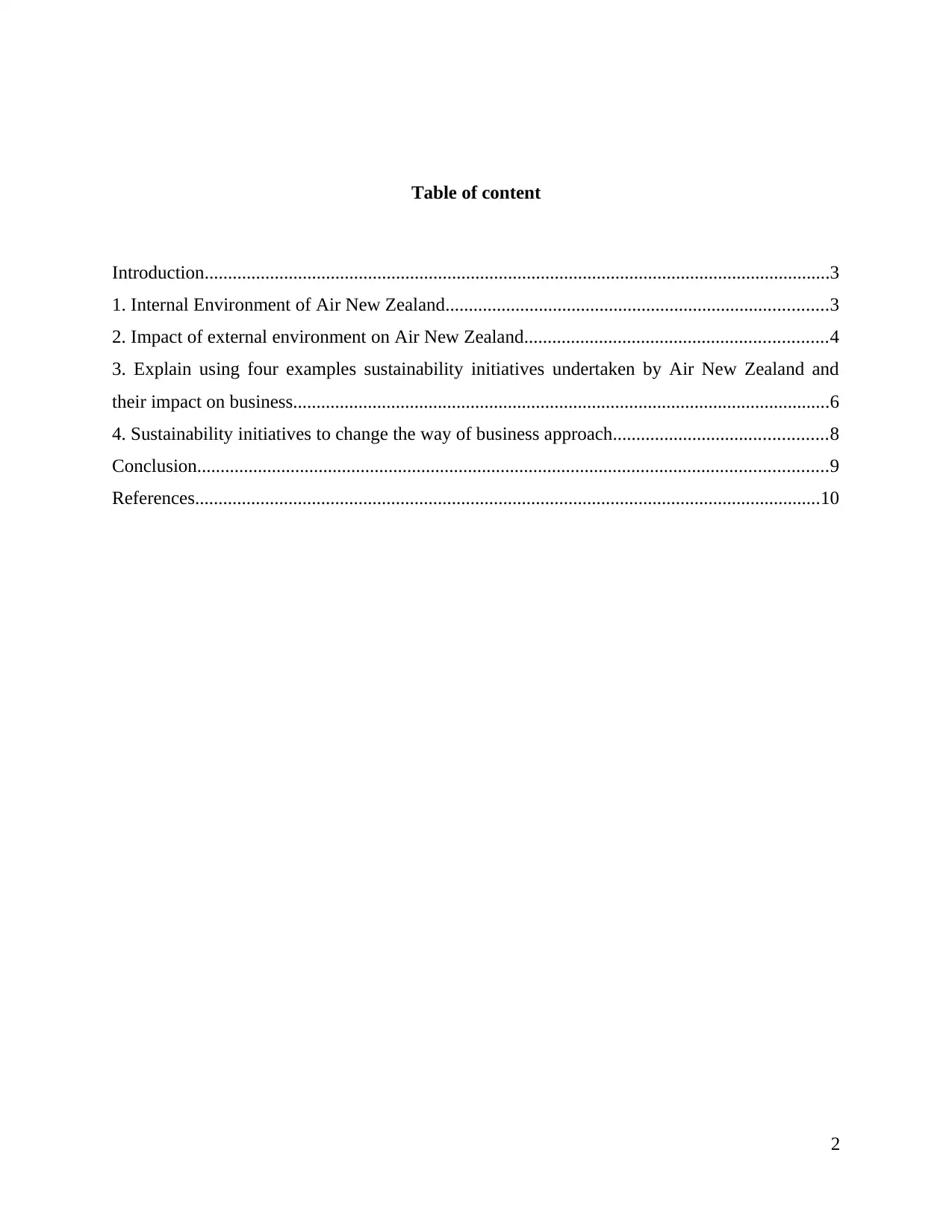
Table of content
Introduction......................................................................................................................................3
1. Internal Environment of Air New Zealand..................................................................................3
2. Impact of external environment on Air New Zealand.................................................................4
3. Explain using four examples sustainability initiatives undertaken by Air New Zealand and
their impact on business...................................................................................................................6
4. Sustainability initiatives to change the way of business approach..............................................8
Conclusion.......................................................................................................................................9
References......................................................................................................................................10
2
Introduction......................................................................................................................................3
1. Internal Environment of Air New Zealand..................................................................................3
2. Impact of external environment on Air New Zealand.................................................................4
3. Explain using four examples sustainability initiatives undertaken by Air New Zealand and
their impact on business...................................................................................................................6
4. Sustainability initiatives to change the way of business approach..............................................8
Conclusion.......................................................................................................................................9
References......................................................................................................................................10
2
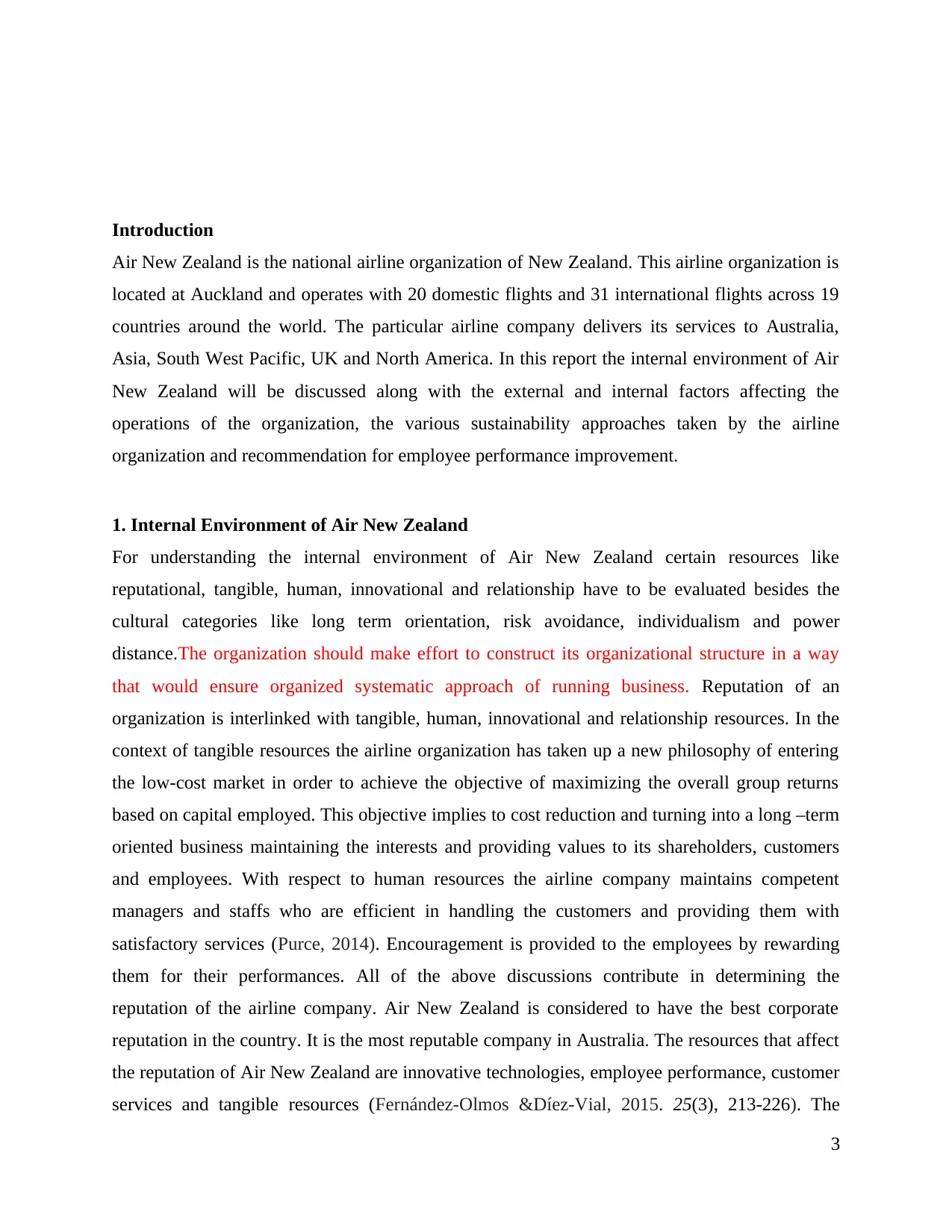
Introduction
Air New Zealand is the national airline organization of New Zealand. This airline organization is
located at Auckland and operates with 20 domestic flights and 31 international flights across 19
countries around the world. The particular airline company delivers its services to Australia,
Asia, South West Pacific, UK and North America. In this report the internal environment of Air
New Zealand will be discussed along with the external and internal factors affecting the
operations of the organization, the various sustainability approaches taken by the airline
organization and recommendation for employee performance improvement.
1. Internal Environment of Air New Zealand
For understanding the internal environment of Air New Zealand certain resources like
reputational, tangible, human, innovational and relationship have to be evaluated besides the
cultural categories like long term orientation, risk avoidance, individualism and power
distance.The organization should make effort to construct its organizational structure in a way
that would ensure organized systematic approach of running business. Reputation of an
organization is interlinked with tangible, human, innovational and relationship resources. In the
context of tangible resources the airline organization has taken up a new philosophy of entering
the low-cost market in order to achieve the objective of maximizing the overall group returns
based on capital employed. This objective implies to cost reduction and turning into a long –term
oriented business maintaining the interests and providing values to its shareholders, customers
and employees. With respect to human resources the airline company maintains competent
managers and staffs who are efficient in handling the customers and providing them with
satisfactory services (Purce, 2014). Encouragement is provided to the employees by rewarding
them for their performances. All of the above discussions contribute in determining the
reputation of the airline company. Air New Zealand is considered to have the best corporate
reputation in the country. It is the most reputable company in Australia. The resources that affect
the reputation of Air New Zealand are innovative technologies, employee performance, customer
services and tangible resources (Fernández-Olmos &Díez-Vial, 2015. 25(3), 213-226). The
3
Air New Zealand is the national airline organization of New Zealand. This airline organization is
located at Auckland and operates with 20 domestic flights and 31 international flights across 19
countries around the world. The particular airline company delivers its services to Australia,
Asia, South West Pacific, UK and North America. In this report the internal environment of Air
New Zealand will be discussed along with the external and internal factors affecting the
operations of the organization, the various sustainability approaches taken by the airline
organization and recommendation for employee performance improvement.
1. Internal Environment of Air New Zealand
For understanding the internal environment of Air New Zealand certain resources like
reputational, tangible, human, innovational and relationship have to be evaluated besides the
cultural categories like long term orientation, risk avoidance, individualism and power
distance.The organization should make effort to construct its organizational structure in a way
that would ensure organized systematic approach of running business. Reputation of an
organization is interlinked with tangible, human, innovational and relationship resources. In the
context of tangible resources the airline organization has taken up a new philosophy of entering
the low-cost market in order to achieve the objective of maximizing the overall group returns
based on capital employed. This objective implies to cost reduction and turning into a long –term
oriented business maintaining the interests and providing values to its shareholders, customers
and employees. With respect to human resources the airline company maintains competent
managers and staffs who are efficient in handling the customers and providing them with
satisfactory services (Purce, 2014). Encouragement is provided to the employees by rewarding
them for their performances. All of the above discussions contribute in determining the
reputation of the airline company. Air New Zealand is considered to have the best corporate
reputation in the country. It is the most reputable company in Australia. The resources that affect
the reputation of Air New Zealand are innovative technologies, employee performance, customer
services and tangible resources (Fernández-Olmos &Díez-Vial, 2015. 25(3), 213-226). The
3
⊘ This is a preview!⊘
Do you want full access?
Subscribe today to unlock all pages.

Trusted by 1+ million students worldwide
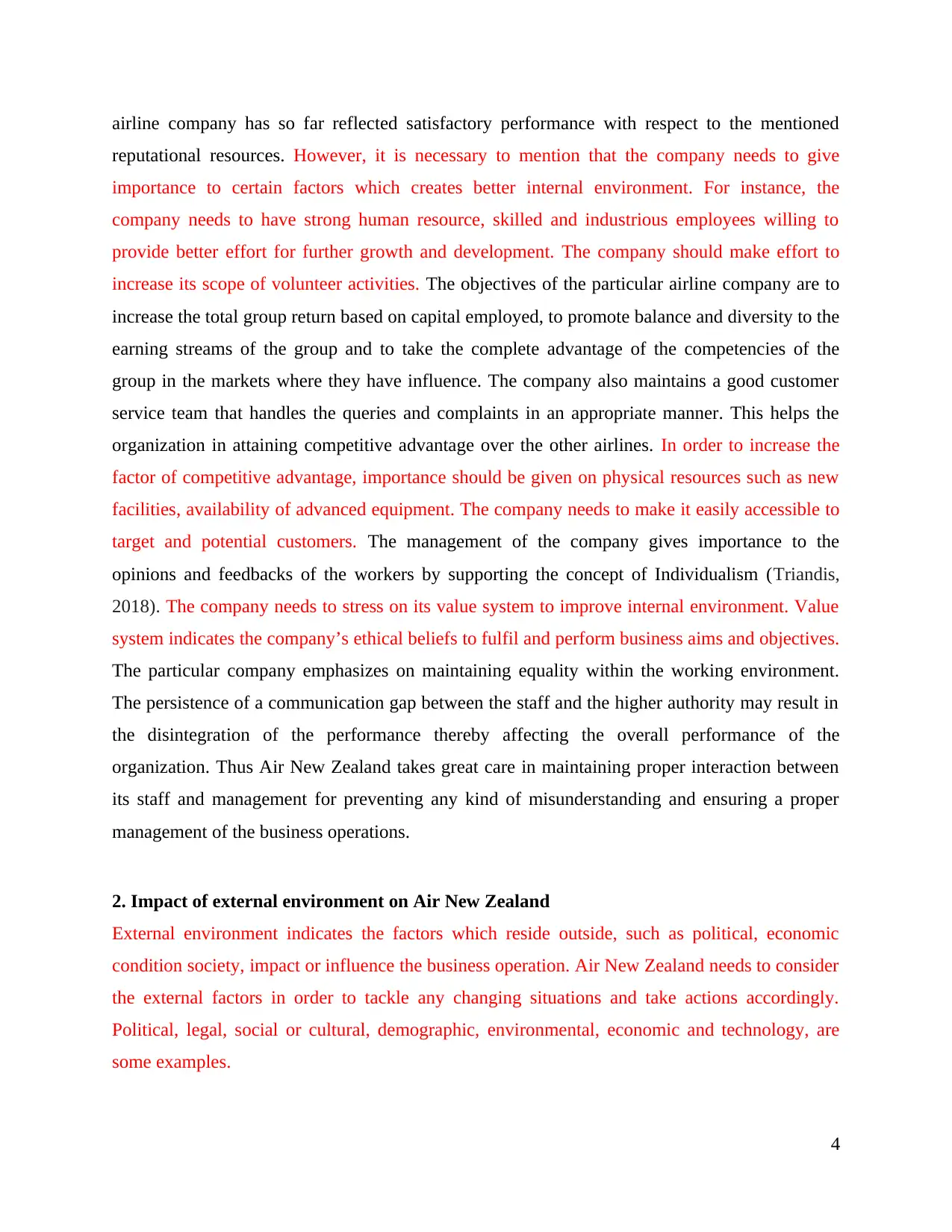
airline company has so far reflected satisfactory performance with respect to the mentioned
reputational resources. However, it is necessary to mention that the company needs to give
importance to certain factors which creates better internal environment. For instance, the
company needs to have strong human resource, skilled and industrious employees willing to
provide better effort for further growth and development. The company should make effort to
increase its scope of volunteer activities. The objectives of the particular airline company are to
increase the total group return based on capital employed, to promote balance and diversity to the
earning streams of the group and to take the complete advantage of the competencies of the
group in the markets where they have influence. The company also maintains a good customer
service team that handles the queries and complaints in an appropriate manner. This helps the
organization in attaining competitive advantage over the other airlines. In order to increase the
factor of competitive advantage, importance should be given on physical resources such as new
facilities, availability of advanced equipment. The company needs to make it easily accessible to
target and potential customers. The management of the company gives importance to the
opinions and feedbacks of the workers by supporting the concept of Individualism (Triandis,
2018). The company needs to stress on its value system to improve internal environment. Value
system indicates the company’s ethical beliefs to fulfil and perform business aims and objectives.
The particular company emphasizes on maintaining equality within the working environment.
The persistence of a communication gap between the staff and the higher authority may result in
the disintegration of the performance thereby affecting the overall performance of the
organization. Thus Air New Zealand takes great care in maintaining proper interaction between
its staff and management for preventing any kind of misunderstanding and ensuring a proper
management of the business operations.
2. Impact of external environment on Air New Zealand
External environment indicates the factors which reside outside, such as political, economic
condition society, impact or influence the business operation. Air New Zealand needs to consider
the external factors in order to tackle any changing situations and take actions accordingly.
Political, legal, social or cultural, demographic, environmental, economic and technology, are
some examples.
4
reputational resources. However, it is necessary to mention that the company needs to give
importance to certain factors which creates better internal environment. For instance, the
company needs to have strong human resource, skilled and industrious employees willing to
provide better effort for further growth and development. The company should make effort to
increase its scope of volunteer activities. The objectives of the particular airline company are to
increase the total group return based on capital employed, to promote balance and diversity to the
earning streams of the group and to take the complete advantage of the competencies of the
group in the markets where they have influence. The company also maintains a good customer
service team that handles the queries and complaints in an appropriate manner. This helps the
organization in attaining competitive advantage over the other airlines. In order to increase the
factor of competitive advantage, importance should be given on physical resources such as new
facilities, availability of advanced equipment. The company needs to make it easily accessible to
target and potential customers. The management of the company gives importance to the
opinions and feedbacks of the workers by supporting the concept of Individualism (Triandis,
2018). The company needs to stress on its value system to improve internal environment. Value
system indicates the company’s ethical beliefs to fulfil and perform business aims and objectives.
The particular company emphasizes on maintaining equality within the working environment.
The persistence of a communication gap between the staff and the higher authority may result in
the disintegration of the performance thereby affecting the overall performance of the
organization. Thus Air New Zealand takes great care in maintaining proper interaction between
its staff and management for preventing any kind of misunderstanding and ensuring a proper
management of the business operations.
2. Impact of external environment on Air New Zealand
External environment indicates the factors which reside outside, such as political, economic
condition society, impact or influence the business operation. Air New Zealand needs to consider
the external factors in order to tackle any changing situations and take actions accordingly.
Political, legal, social or cultural, demographic, environmental, economic and technology, are
some examples.
4
Paraphrase This Document
Need a fresh take? Get an instant paraphrase of this document with our AI Paraphraser
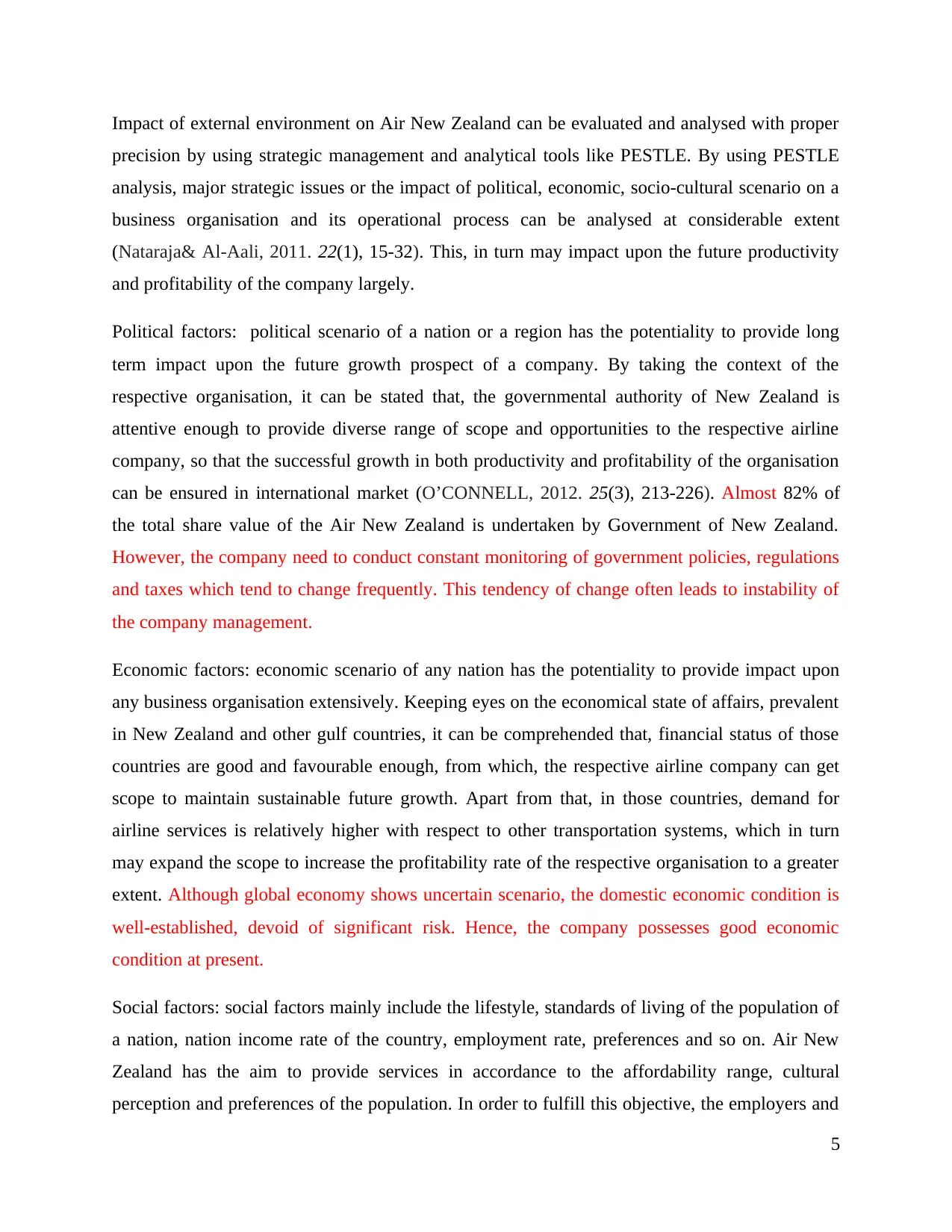
Impact of external environment on Air New Zealand can be evaluated and analysed with proper
precision by using strategic management and analytical tools like PESTLE. By using PESTLE
analysis, major strategic issues or the impact of political, economic, socio-cultural scenario on a
business organisation and its operational process can be analysed at considerable extent
(Nataraja& Al-Aali, 2011. 22(1), 15-32). This, in turn may impact upon the future productivity
and profitability of the company largely.
Political factors: political scenario of a nation or a region has the potentiality to provide long
term impact upon the future growth prospect of a company. By taking the context of the
respective organisation, it can be stated that, the governmental authority of New Zealand is
attentive enough to provide diverse range of scope and opportunities to the respective airline
company, so that the successful growth in both productivity and profitability of the organisation
can be ensured in international market (O’CONNELL, 2012. 25(3), 213-226). Almost 82% of
the total share value of the Air New Zealand is undertaken by Government of New Zealand.
However, the company need to conduct constant monitoring of government policies, regulations
and taxes which tend to change frequently. This tendency of change often leads to instability of
the company management.
Economic factors: economic scenario of any nation has the potentiality to provide impact upon
any business organisation extensively. Keeping eyes on the economical state of affairs, prevalent
in New Zealand and other gulf countries, it can be comprehended that, financial status of those
countries are good and favourable enough, from which, the respective airline company can get
scope to maintain sustainable future growth. Apart from that, in those countries, demand for
airline services is relatively higher with respect to other transportation systems, which in turn
may expand the scope to increase the profitability rate of the respective organisation to a greater
extent. Although global economy shows uncertain scenario, the domestic economic condition is
well-established, devoid of significant risk. Hence, the company possesses good economic
condition at present.
Social factors: social factors mainly include the lifestyle, standards of living of the population of
a nation, nation income rate of the country, employment rate, preferences and so on. Air New
Zealand has the aim to provide services in accordance to the affordability range, cultural
perception and preferences of the population. In order to fulfill this objective, the employers and
5
precision by using strategic management and analytical tools like PESTLE. By using PESTLE
analysis, major strategic issues or the impact of political, economic, socio-cultural scenario on a
business organisation and its operational process can be analysed at considerable extent
(Nataraja& Al-Aali, 2011. 22(1), 15-32). This, in turn may impact upon the future productivity
and profitability of the company largely.
Political factors: political scenario of a nation or a region has the potentiality to provide long
term impact upon the future growth prospect of a company. By taking the context of the
respective organisation, it can be stated that, the governmental authority of New Zealand is
attentive enough to provide diverse range of scope and opportunities to the respective airline
company, so that the successful growth in both productivity and profitability of the organisation
can be ensured in international market (O’CONNELL, 2012. 25(3), 213-226). Almost 82% of
the total share value of the Air New Zealand is undertaken by Government of New Zealand.
However, the company need to conduct constant monitoring of government policies, regulations
and taxes which tend to change frequently. This tendency of change often leads to instability of
the company management.
Economic factors: economic scenario of any nation has the potentiality to provide impact upon
any business organisation extensively. Keeping eyes on the economical state of affairs, prevalent
in New Zealand and other gulf countries, it can be comprehended that, financial status of those
countries are good and favourable enough, from which, the respective airline company can get
scope to maintain sustainable future growth. Apart from that, in those countries, demand for
airline services is relatively higher with respect to other transportation systems, which in turn
may expand the scope to increase the profitability rate of the respective organisation to a greater
extent. Although global economy shows uncertain scenario, the domestic economic condition is
well-established, devoid of significant risk. Hence, the company possesses good economic
condition at present.
Social factors: social factors mainly include the lifestyle, standards of living of the population of
a nation, nation income rate of the country, employment rate, preferences and so on. Air New
Zealand has the aim to provide services in accordance to the affordability range, cultural
perception and preferences of the population. In order to fulfill this objective, the employers and
5
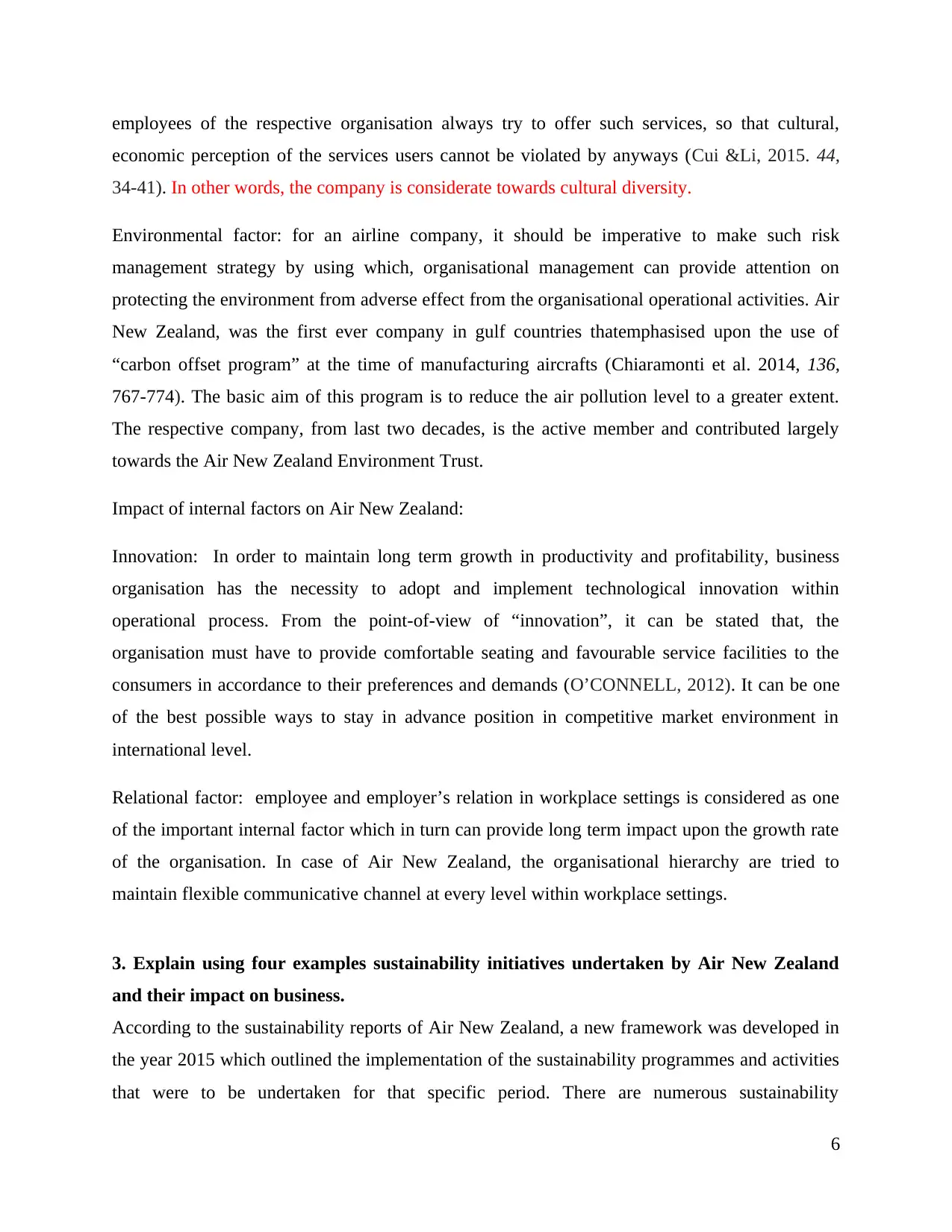
employees of the respective organisation always try to offer such services, so that cultural,
economic perception of the services users cannot be violated by anyways (Cui &Li, 2015. 44,
34-41). In other words, the company is considerate towards cultural diversity.
Environmental factor: for an airline company, it should be imperative to make such risk
management strategy by using which, organisational management can provide attention on
protecting the environment from adverse effect from the organisational operational activities. Air
New Zealand, was the first ever company in gulf countries thatemphasised upon the use of
“carbon offset program” at the time of manufacturing aircrafts (Chiaramonti et al. 2014, 136,
767-774). The basic aim of this program is to reduce the air pollution level to a greater extent.
The respective company, from last two decades, is the active member and contributed largely
towards the Air New Zealand Environment Trust.
Impact of internal factors on Air New Zealand:
Innovation: In order to maintain long term growth in productivity and profitability, business
organisation has the necessity to adopt and implement technological innovation within
operational process. From the point-of-view of “innovation”, it can be stated that, the
organisation must have to provide comfortable seating and favourable service facilities to the
consumers in accordance to their preferences and demands (O’CONNELL, 2012). It can be one
of the best possible ways to stay in advance position in competitive market environment in
international level.
Relational factor: employee and employer’s relation in workplace settings is considered as one
of the important internal factor which in turn can provide long term impact upon the growth rate
of the organisation. In case of Air New Zealand, the organisational hierarchy are tried to
maintain flexible communicative channel at every level within workplace settings.
3. Explain using four examples sustainability initiatives undertaken by Air New Zealand
and their impact on business.
According to the sustainability reports of Air New Zealand, a new framework was developed in
the year 2015 which outlined the implementation of the sustainability programmes and activities
that were to be undertaken for that specific period. There are numerous sustainability
6
economic perception of the services users cannot be violated by anyways (Cui &Li, 2015. 44,
34-41). In other words, the company is considerate towards cultural diversity.
Environmental factor: for an airline company, it should be imperative to make such risk
management strategy by using which, organisational management can provide attention on
protecting the environment from adverse effect from the organisational operational activities. Air
New Zealand, was the first ever company in gulf countries thatemphasised upon the use of
“carbon offset program” at the time of manufacturing aircrafts (Chiaramonti et al. 2014, 136,
767-774). The basic aim of this program is to reduce the air pollution level to a greater extent.
The respective company, from last two decades, is the active member and contributed largely
towards the Air New Zealand Environment Trust.
Impact of internal factors on Air New Zealand:
Innovation: In order to maintain long term growth in productivity and profitability, business
organisation has the necessity to adopt and implement technological innovation within
operational process. From the point-of-view of “innovation”, it can be stated that, the
organisation must have to provide comfortable seating and favourable service facilities to the
consumers in accordance to their preferences and demands (O’CONNELL, 2012). It can be one
of the best possible ways to stay in advance position in competitive market environment in
international level.
Relational factor: employee and employer’s relation in workplace settings is considered as one
of the important internal factor which in turn can provide long term impact upon the growth rate
of the organisation. In case of Air New Zealand, the organisational hierarchy are tried to
maintain flexible communicative channel at every level within workplace settings.
3. Explain using four examples sustainability initiatives undertaken by Air New Zealand
and their impact on business.
According to the sustainability reports of Air New Zealand, a new framework was developed in
the year 2015 which outlined the implementation of the sustainability programmes and activities
that were to be undertaken for that specific period. There are numerous sustainability
6
⊘ This is a preview!⊘
Do you want full access?
Subscribe today to unlock all pages.

Trusted by 1+ million students worldwide
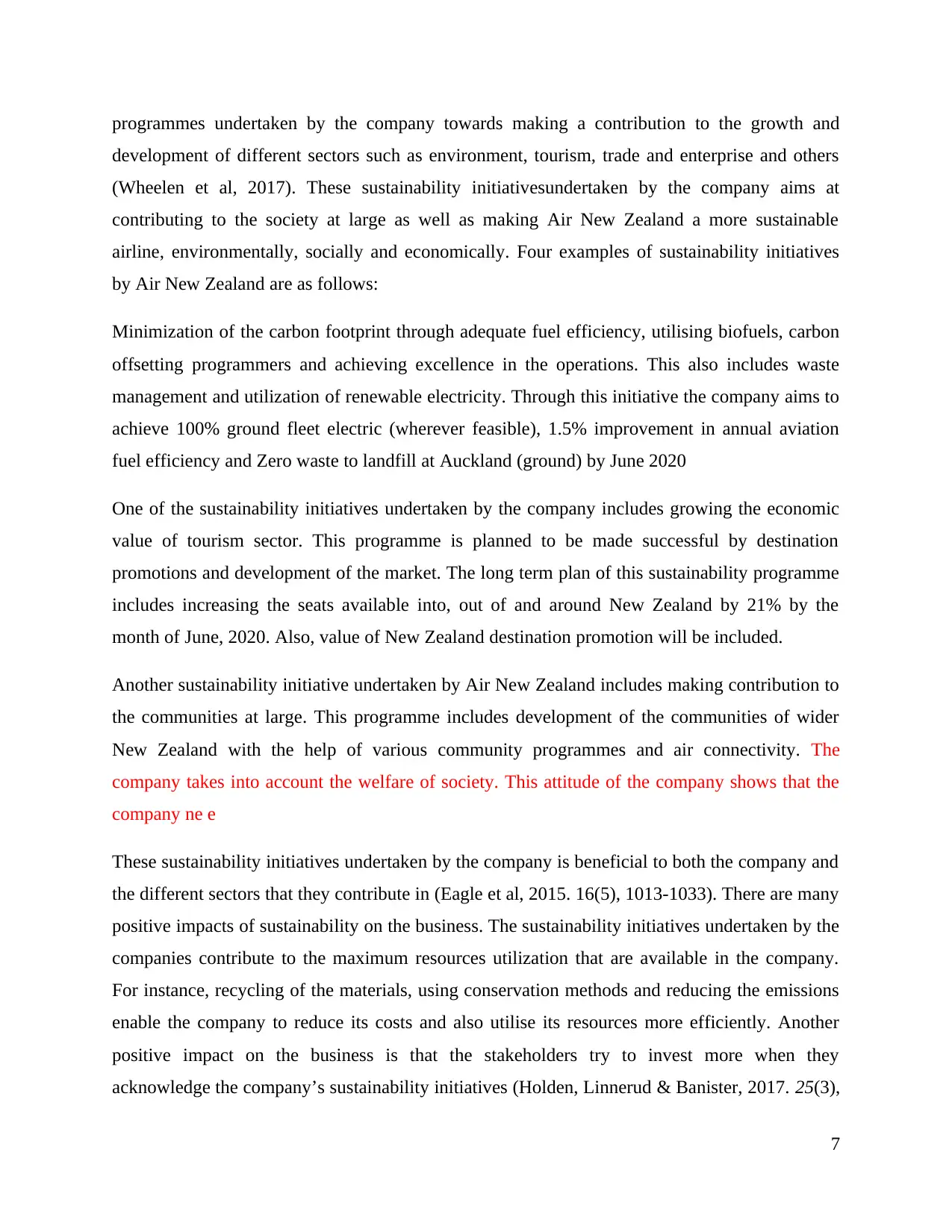
programmes undertaken by the company towards making a contribution to the growth and
development of different sectors such as environment, tourism, trade and enterprise and others
(Wheelen et al, 2017). These sustainability initiativesundertaken by the company aims at
contributing to the society at large as well as making Air New Zealand a more sustainable
airline, environmentally, socially and economically. Four examples of sustainability initiatives
by Air New Zealand are as follows:
Minimization of the carbon footprint through adequate fuel efficiency, utilising biofuels, carbon
offsetting programmers and achieving excellence in the operations. This also includes waste
management and utilization of renewable electricity. Through this initiative the company aims to
achieve 100% ground fleet electric (wherever feasible), 1.5% improvement in annual aviation
fuel efficiency and Zero waste to landfill at Auckland (ground) by June 2020
One of the sustainability initiatives undertaken by the company includes growing the economic
value of tourism sector. This programme is planned to be made successful by destination
promotions and development of the market. The long term plan of this sustainability programme
includes increasing the seats available into, out of and around New Zealand by 21% by the
month of June, 2020. Also, value of New Zealand destination promotion will be included.
Another sustainability initiative undertaken by Air New Zealand includes making contribution to
the communities at large. This programme includes development of the communities of wider
New Zealand with the help of various community programmes and air connectivity. The
company takes into account the welfare of society. This attitude of the company shows that the
company ne e
These sustainability initiatives undertaken by the company is beneficial to both the company and
the different sectors that they contribute in (Eagle et al, 2015. 16(5), 1013-1033). There are many
positive impacts of sustainability on the business. The sustainability initiatives undertaken by the
companies contribute to the maximum resources utilization that are available in the company.
For instance, recycling of the materials, using conservation methods and reducing the emissions
enable the company to reduce its costs and also utilise its resources more efficiently. Another
positive impact on the business is that the stakeholders try to invest more when they
acknowledge the company’s sustainability initiatives (Holden, Linnerud & Banister, 2017. 25(3),
7
development of different sectors such as environment, tourism, trade and enterprise and others
(Wheelen et al, 2017). These sustainability initiativesundertaken by the company aims at
contributing to the society at large as well as making Air New Zealand a more sustainable
airline, environmentally, socially and economically. Four examples of sustainability initiatives
by Air New Zealand are as follows:
Minimization of the carbon footprint through adequate fuel efficiency, utilising biofuels, carbon
offsetting programmers and achieving excellence in the operations. This also includes waste
management and utilization of renewable electricity. Through this initiative the company aims to
achieve 100% ground fleet electric (wherever feasible), 1.5% improvement in annual aviation
fuel efficiency and Zero waste to landfill at Auckland (ground) by June 2020
One of the sustainability initiatives undertaken by the company includes growing the economic
value of tourism sector. This programme is planned to be made successful by destination
promotions and development of the market. The long term plan of this sustainability programme
includes increasing the seats available into, out of and around New Zealand by 21% by the
month of June, 2020. Also, value of New Zealand destination promotion will be included.
Another sustainability initiative undertaken by Air New Zealand includes making contribution to
the communities at large. This programme includes development of the communities of wider
New Zealand with the help of various community programmes and air connectivity. The
company takes into account the welfare of society. This attitude of the company shows that the
company ne e
These sustainability initiatives undertaken by the company is beneficial to both the company and
the different sectors that they contribute in (Eagle et al, 2015. 16(5), 1013-1033). There are many
positive impacts of sustainability on the business. The sustainability initiatives undertaken by the
companies contribute to the maximum resources utilization that are available in the company.
For instance, recycling of the materials, using conservation methods and reducing the emissions
enable the company to reduce its costs and also utilise its resources more efficiently. Another
positive impact on the business is that the stakeholders try to invest more when they
acknowledge the company’s sustainability initiatives (Holden, Linnerud & Banister, 2017. 25(3),
7
Paraphrase This Document
Need a fresh take? Get an instant paraphrase of this document with our AI Paraphraser
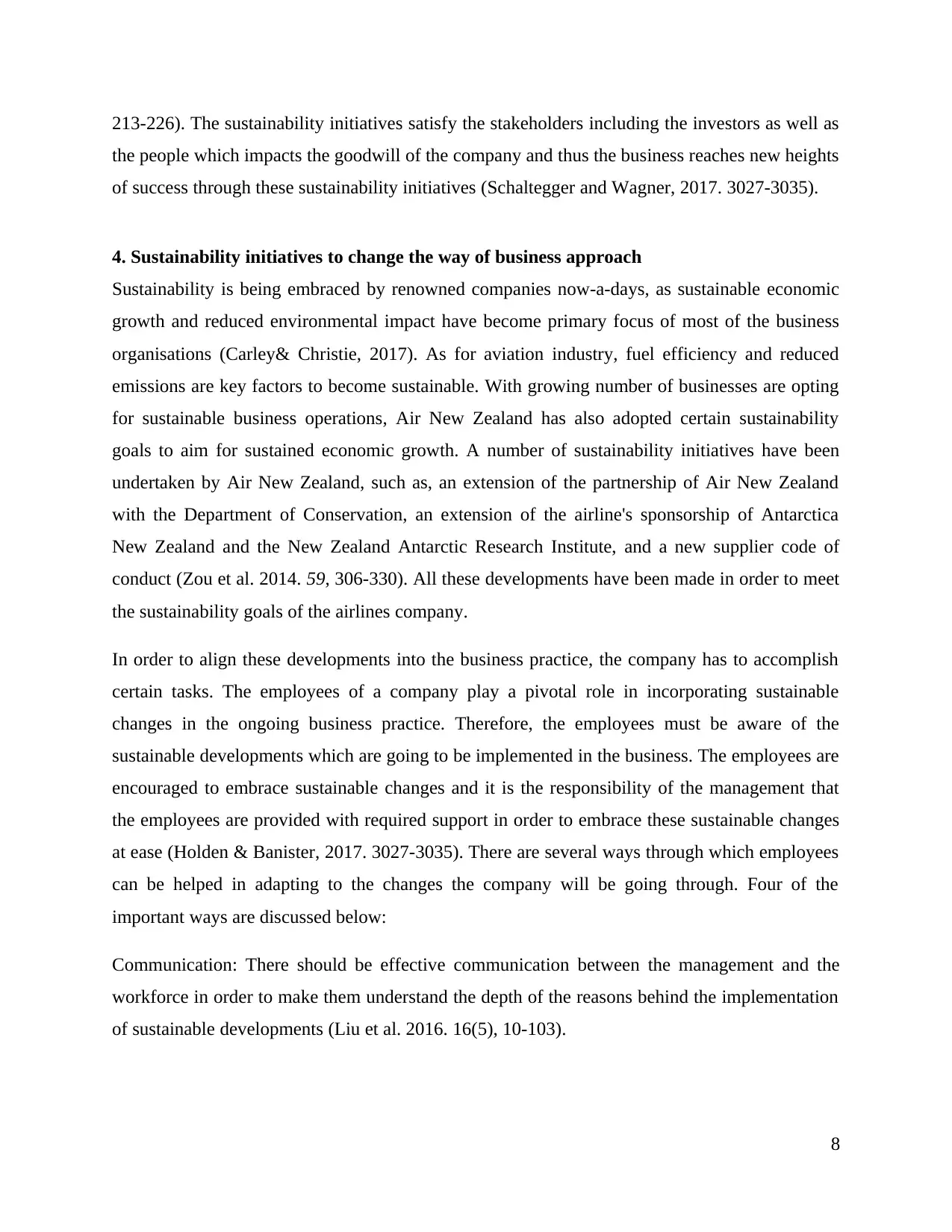
213-226). The sustainability initiatives satisfy the stakeholders including the investors as well as
the people which impacts the goodwill of the company and thus the business reaches new heights
of success through these sustainability initiatives (Schaltegger and Wagner, 2017. 3027-3035).
4. Sustainability initiatives to change the way of business approach
Sustainability is being embraced by renowned companies now-a-days, as sustainable economic
growth and reduced environmental impact have become primary focus of most of the business
organisations (Carley& Christie, 2017). As for aviation industry, fuel efficiency and reduced
emissions are key factors to become sustainable. With growing number of businesses are opting
for sustainable business operations, Air New Zealand has also adopted certain sustainability
goals to aim for sustained economic growth. A number of sustainability initiatives have been
undertaken by Air New Zealand, such as, an extension of the partnership of Air New Zealand
with the Department of Conservation, an extension of the airline's sponsorship of Antarctica
New Zealand and the New Zealand Antarctic Research Institute, and a new supplier code of
conduct (Zou et al. 2014. 59, 306-330). All these developments have been made in order to meet
the sustainability goals of the airlines company.
In order to align these developments into the business practice, the company has to accomplish
certain tasks. The employees of a company play a pivotal role in incorporating sustainable
changes in the ongoing business practice. Therefore, the employees must be aware of the
sustainable developments which are going to be implemented in the business. The employees are
encouraged to embrace sustainable changes and it is the responsibility of the management that
the employees are provided with required support in order to embrace these sustainable changes
at ease (Holden & Banister, 2017. 3027-3035). There are several ways through which employees
can be helped in adapting to the changes the company will be going through. Four of the
important ways are discussed below:
Communication: There should be effective communication between the management and the
workforce in order to make them understand the depth of the reasons behind the implementation
of sustainable developments (Liu et al. 2016. 16(5), 10-103).
8
the people which impacts the goodwill of the company and thus the business reaches new heights
of success through these sustainability initiatives (Schaltegger and Wagner, 2017. 3027-3035).
4. Sustainability initiatives to change the way of business approach
Sustainability is being embraced by renowned companies now-a-days, as sustainable economic
growth and reduced environmental impact have become primary focus of most of the business
organisations (Carley& Christie, 2017). As for aviation industry, fuel efficiency and reduced
emissions are key factors to become sustainable. With growing number of businesses are opting
for sustainable business operations, Air New Zealand has also adopted certain sustainability
goals to aim for sustained economic growth. A number of sustainability initiatives have been
undertaken by Air New Zealand, such as, an extension of the partnership of Air New Zealand
with the Department of Conservation, an extension of the airline's sponsorship of Antarctica
New Zealand and the New Zealand Antarctic Research Institute, and a new supplier code of
conduct (Zou et al. 2014. 59, 306-330). All these developments have been made in order to meet
the sustainability goals of the airlines company.
In order to align these developments into the business practice, the company has to accomplish
certain tasks. The employees of a company play a pivotal role in incorporating sustainable
changes in the ongoing business practice. Therefore, the employees must be aware of the
sustainable developments which are going to be implemented in the business. The employees are
encouraged to embrace sustainable changes and it is the responsibility of the management that
the employees are provided with required support in order to embrace these sustainable changes
at ease (Holden & Banister, 2017. 3027-3035). There are several ways through which employees
can be helped in adapting to the changes the company will be going through. Four of the
important ways are discussed below:
Communication: There should be effective communication between the management and the
workforce in order to make them understand the depth of the reasons behind the implementation
of sustainable developments (Liu et al. 2016. 16(5), 10-103).
8
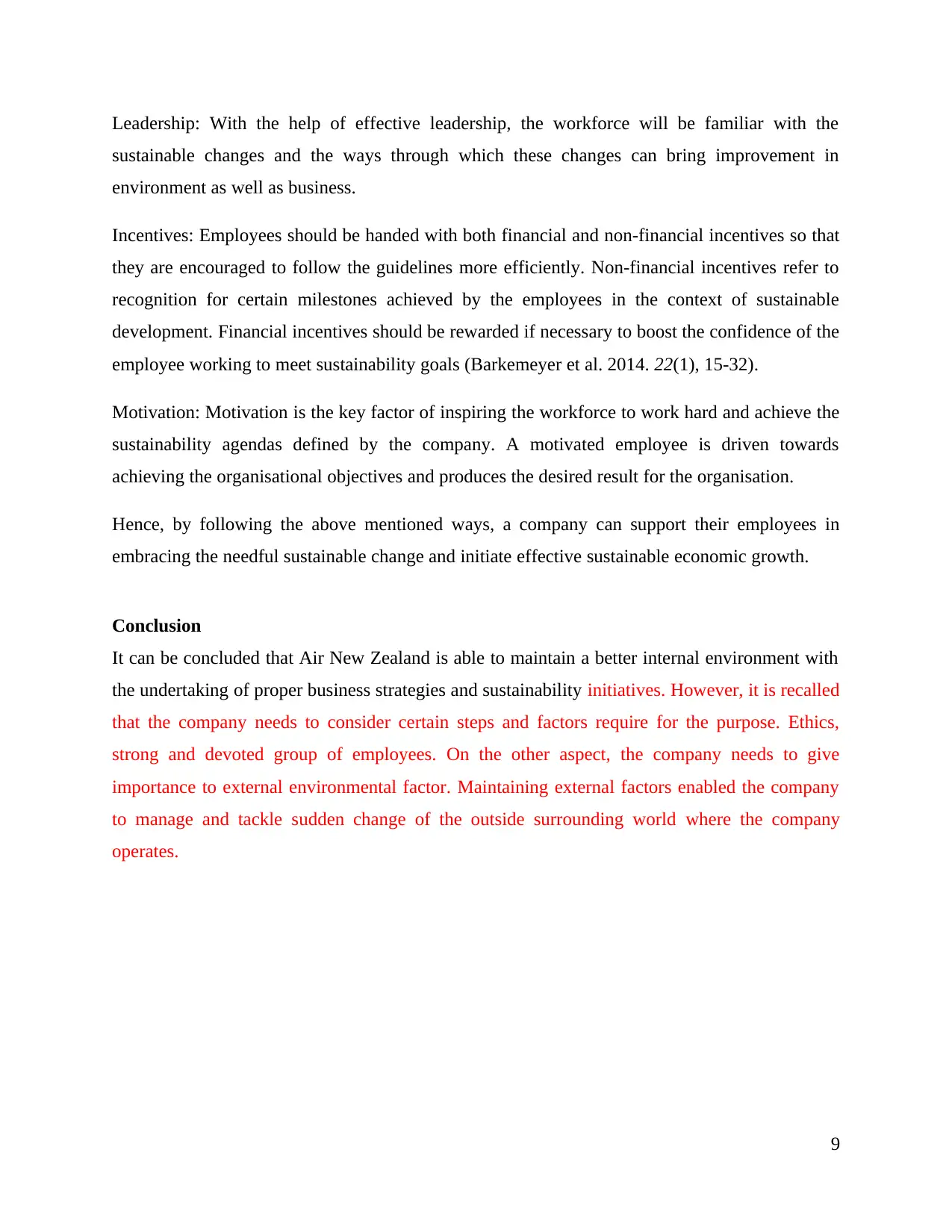
Leadership: With the help of effective leadership, the workforce will be familiar with the
sustainable changes and the ways through which these changes can bring improvement in
environment as well as business.
Incentives: Employees should be handed with both financial and non-financial incentives so that
they are encouraged to follow the guidelines more efficiently. Non-financial incentives refer to
recognition for certain milestones achieved by the employees in the context of sustainable
development. Financial incentives should be rewarded if necessary to boost the confidence of the
employee working to meet sustainability goals (Barkemeyer et al. 2014. 22(1), 15-32).
Motivation: Motivation is the key factor of inspiring the workforce to work hard and achieve the
sustainability agendas defined by the company. A motivated employee is driven towards
achieving the organisational objectives and produces the desired result for the organisation.
Hence, by following the above mentioned ways, a company can support their employees in
embracing the needful sustainable change and initiate effective sustainable economic growth.
Conclusion
It can be concluded that Air New Zealand is able to maintain a better internal environment with
the undertaking of proper business strategies and sustainability initiatives. However, it is recalled
that the company needs to consider certain steps and factors require for the purpose. Ethics,
strong and devoted group of employees. On the other aspect, the company needs to give
importance to external environmental factor. Maintaining external factors enabled the company
to manage and tackle sudden change of the outside surrounding world where the company
operates.
9
sustainable changes and the ways through which these changes can bring improvement in
environment as well as business.
Incentives: Employees should be handed with both financial and non-financial incentives so that
they are encouraged to follow the guidelines more efficiently. Non-financial incentives refer to
recognition for certain milestones achieved by the employees in the context of sustainable
development. Financial incentives should be rewarded if necessary to boost the confidence of the
employee working to meet sustainability goals (Barkemeyer et al. 2014. 22(1), 15-32).
Motivation: Motivation is the key factor of inspiring the workforce to work hard and achieve the
sustainability agendas defined by the company. A motivated employee is driven towards
achieving the organisational objectives and produces the desired result for the organisation.
Hence, by following the above mentioned ways, a company can support their employees in
embracing the needful sustainable change and initiate effective sustainable economic growth.
Conclusion
It can be concluded that Air New Zealand is able to maintain a better internal environment with
the undertaking of proper business strategies and sustainability initiatives. However, it is recalled
that the company needs to consider certain steps and factors require for the purpose. Ethics,
strong and devoted group of employees. On the other aspect, the company needs to give
importance to external environmental factor. Maintaining external factors enabled the company
to manage and tackle sudden change of the outside surrounding world where the company
operates.
9
⊘ This is a preview!⊘
Do you want full access?
Subscribe today to unlock all pages.

Trusted by 1+ million students worldwide
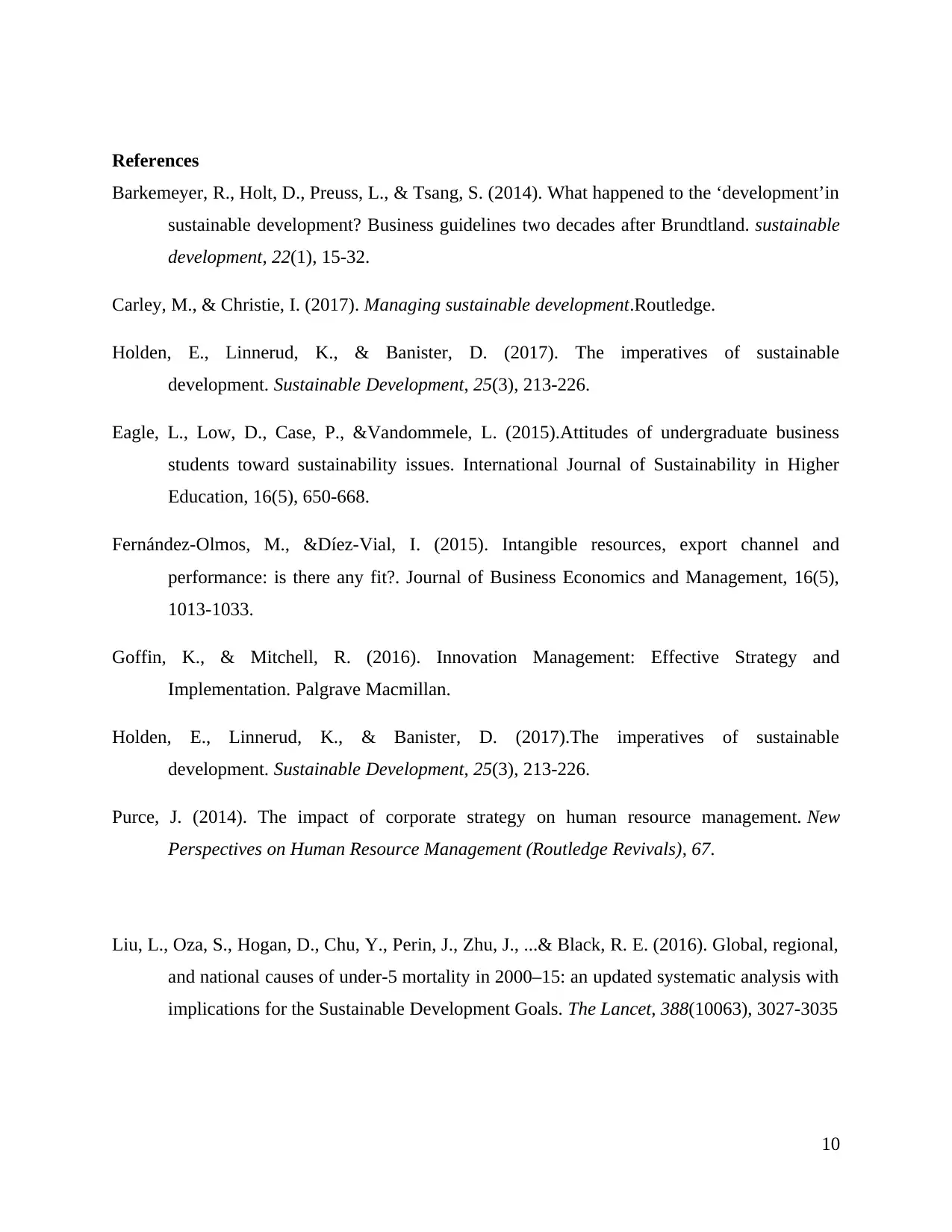
References
Barkemeyer, R., Holt, D., Preuss, L., & Tsang, S. (2014). What happened to the ‘development’in
sustainable development? Business guidelines two decades after Brundtland. sustainable
development, 22(1), 15-32.
Carley, M., & Christie, I. (2017). Managing sustainable development.Routledge.
Holden, E., Linnerud, K., & Banister, D. (2017). The imperatives of sustainable
development. Sustainable Development, 25(3), 213-226.
Eagle, L., Low, D., Case, P., &Vandommele, L. (2015).Attitudes of undergraduate business
students toward sustainability issues. International Journal of Sustainability in Higher
Education, 16(5), 650-668.
Fernández-Olmos, M., &Díez-Vial, I. (2015). Intangible resources, export channel and
performance: is there any fit?. Journal of Business Economics and Management, 16(5),
1013-1033.
Goffin, K., & Mitchell, R. (2016). Innovation Management: Effective Strategy and
Implementation. Palgrave Macmillan.
Holden, E., Linnerud, K., & Banister, D. (2017).The imperatives of sustainable
development. Sustainable Development, 25(3), 213-226.
Purce, J. (2014). The impact of corporate strategy on human resource management. New
Perspectives on Human Resource Management (Routledge Revivals), 67.
Liu, L., Oza, S., Hogan, D., Chu, Y., Perin, J., Zhu, J., ...& Black, R. E. (2016). Global, regional,
and national causes of under-5 mortality in 2000–15: an updated systematic analysis with
implications for the Sustainable Development Goals. The Lancet, 388(10063), 3027-3035
10
Barkemeyer, R., Holt, D., Preuss, L., & Tsang, S. (2014). What happened to the ‘development’in
sustainable development? Business guidelines two decades after Brundtland. sustainable
development, 22(1), 15-32.
Carley, M., & Christie, I. (2017). Managing sustainable development.Routledge.
Holden, E., Linnerud, K., & Banister, D. (2017). The imperatives of sustainable
development. Sustainable Development, 25(3), 213-226.
Eagle, L., Low, D., Case, P., &Vandommele, L. (2015).Attitudes of undergraduate business
students toward sustainability issues. International Journal of Sustainability in Higher
Education, 16(5), 650-668.
Fernández-Olmos, M., &Díez-Vial, I. (2015). Intangible resources, export channel and
performance: is there any fit?. Journal of Business Economics and Management, 16(5),
1013-1033.
Goffin, K., & Mitchell, R. (2016). Innovation Management: Effective Strategy and
Implementation. Palgrave Macmillan.
Holden, E., Linnerud, K., & Banister, D. (2017).The imperatives of sustainable
development. Sustainable Development, 25(3), 213-226.
Purce, J. (2014). The impact of corporate strategy on human resource management. New
Perspectives on Human Resource Management (Routledge Revivals), 67.
Liu, L., Oza, S., Hogan, D., Chu, Y., Perin, J., Zhu, J., ...& Black, R. E. (2016). Global, regional,
and national causes of under-5 mortality in 2000–15: an updated systematic analysis with
implications for the Sustainable Development Goals. The Lancet, 388(10063), 3027-3035
10
Paraphrase This Document
Need a fresh take? Get an instant paraphrase of this document with our AI Paraphraser
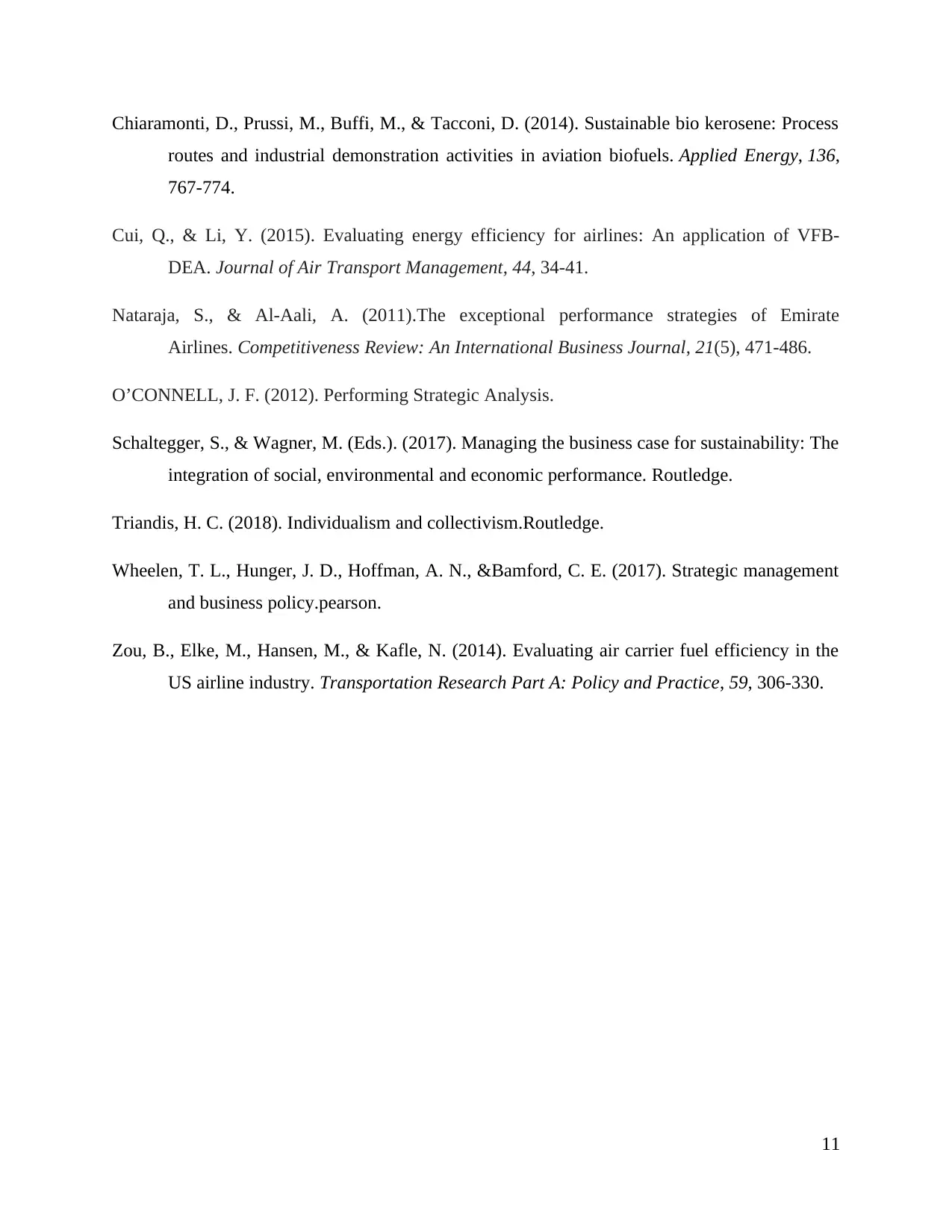
Chiaramonti, D., Prussi, M., Buffi, M., & Tacconi, D. (2014). Sustainable bio kerosene: Process
routes and industrial demonstration activities in aviation biofuels. Applied Energy, 136,
767-774.
Cui, Q., & Li, Y. (2015). Evaluating energy efficiency for airlines: An application of VFB-
DEA. Journal of Air Transport Management, 44, 34-41.
Nataraja, S., & Al-Aali, A. (2011).The exceptional performance strategies of Emirate
Airlines. Competitiveness Review: An International Business Journal, 21(5), 471-486.
O’CONNELL, J. F. (2012). Performing Strategic Analysis.
Schaltegger, S., & Wagner, M. (Eds.). (2017). Managing the business case for sustainability: The
integration of social, environmental and economic performance. Routledge.
Triandis, H. C. (2018). Individualism and collectivism.Routledge.
Wheelen, T. L., Hunger, J. D., Hoffman, A. N., &Bamford, C. E. (2017). Strategic management
and business policy.pearson.
Zou, B., Elke, M., Hansen, M., & Kafle, N. (2014). Evaluating air carrier fuel efficiency in the
US airline industry. Transportation Research Part A: Policy and Practice, 59, 306-330.
11
routes and industrial demonstration activities in aviation biofuels. Applied Energy, 136,
767-774.
Cui, Q., & Li, Y. (2015). Evaluating energy efficiency for airlines: An application of VFB-
DEA. Journal of Air Transport Management, 44, 34-41.
Nataraja, S., & Al-Aali, A. (2011).The exceptional performance strategies of Emirate
Airlines. Competitiveness Review: An International Business Journal, 21(5), 471-486.
O’CONNELL, J. F. (2012). Performing Strategic Analysis.
Schaltegger, S., & Wagner, M. (Eds.). (2017). Managing the business case for sustainability: The
integration of social, environmental and economic performance. Routledge.
Triandis, H. C. (2018). Individualism and collectivism.Routledge.
Wheelen, T. L., Hunger, J. D., Hoffman, A. N., &Bamford, C. E. (2017). Strategic management
and business policy.pearson.
Zou, B., Elke, M., Hansen, M., & Kafle, N. (2014). Evaluating air carrier fuel efficiency in the
US airline industry. Transportation Research Part A: Policy and Practice, 59, 306-330.
11
1 out of 11
Related Documents
Your All-in-One AI-Powered Toolkit for Academic Success.
+13062052269
info@desklib.com
Available 24*7 on WhatsApp / Email
![[object Object]](/_next/static/media/star-bottom.7253800d.svg)
Unlock your academic potential
Copyright © 2020–2025 A2Z Services. All Rights Reserved. Developed and managed by ZUCOL.





